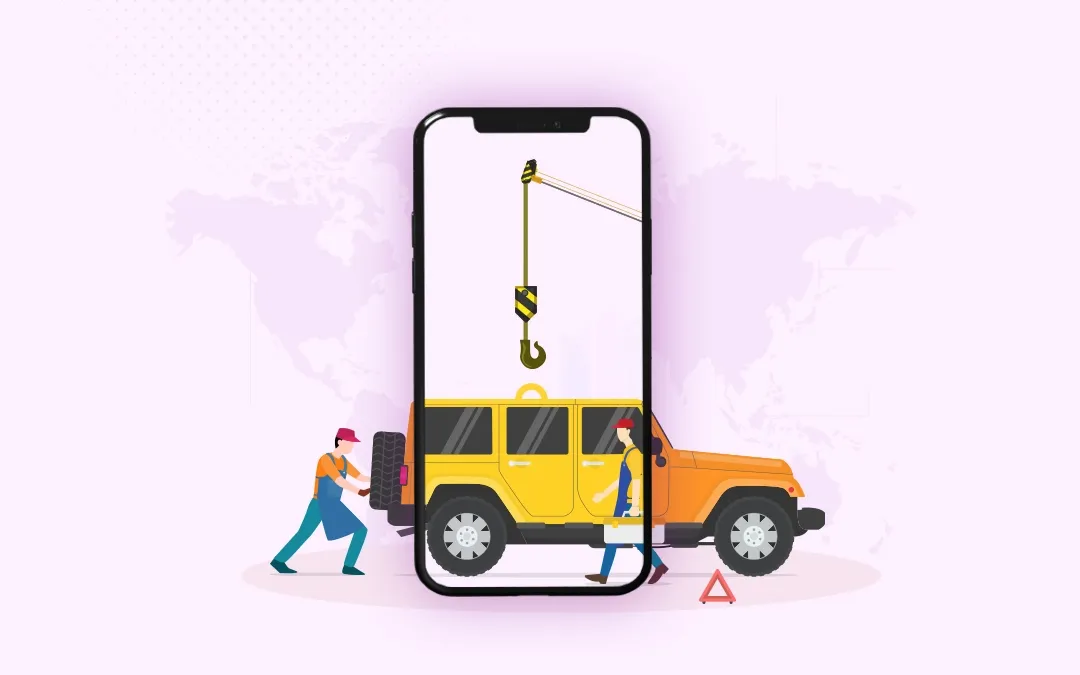
How To Build A Roadside Assistance App Like Uber for Towing
Learn how to build a towing and roadside assistance app. Explore features and development costs.
If you're reading this blog, you may be someone who wants to start a roadside assistance business and is trying to figure out how things work. Or maybe you're someone who’s been in the industry for a while and wants to know how you can grow your business. Either way, you're in the right place to learn. So, keep reading!
Roadside assistance is quickly growing bigger as more people are buying and owning vehicles these days, and with everything being digitalized in our day-to-day lives, it's not a bad time for businesses like roadside assistance to think about creating on-demand apps for their business. It's a way to step beyond the usual and give people what they need when they need it.
In this blog, we'll discuss how you can make an on-demand app for your roadside assistance business. Let's dive in!
How Does an On-demand Roadside Assistance App Work?
So, you know how Uber finds the nearest drivers when you need a ride, right? Well, on-demand roadside assistance works kind of like that.
The only difference is that instead of a driver, it finds someone to fix your vehicle when it breaks down.
Here's how it usually works:
1. User Registration:
Users download the app and register for an account by providing the necessary information such as their name, contact details, location, etc.
2. Service Request:
When they experience an issue that requires roadside assistance, they browse the app and request the specific service they need.
3. Service Provider Fetching:
The app's algorithm matches the user's request with the nearest available service provider and sends them the details of the user's request, with their location.
The service provider can review the request and choose to accept or decline it.
4. Real-Time Tracking:
The user tracks the service provider's location in real-time as they make their way to the user's location.
7. Service Delivery:
The service provider arrives at the user's location and finishes the work.
8. Payment Processing:
After the service is completed, the app processes payment or the user pays with cash.
9. Rating and Feedback:
Finally, the user and the service provider rate each other based on their experience.
10. Payout Processing:
Shortly after the service is completed, the service provider receives the payout directly in their bank account.
With an on-demand roadside assistance app, vehicle owners have peace of mind knowing that help is just a tap away.
Whether they encounter a flat tyre, a dead battery, or any other vehicle issue, they can quickly request assistance through the app, receiving immediate help wherever they are.
Features Needed In an On-demand Roadside Assistance App
In a roadside assistance app, you've got a user who needs help and a service provider who provides that help. The app connects these two.
But wait, there's more! You also need a web panel to keep an eye on how everything's going. So, there are three parts to this system. Now, let's check out the features needed in each of these parts.
Customer App Features
1. Easy Login
To allow users to easily log into the app using their mobile number.
2. Service Selection
For users to be able to select the specific services they need from the many roadside assistance categories available.
3. Real-Time Notifications
To assist the users in getting real-time updates via push notifications regarding the status of their service.
4. Seamless Payments
To allow users to easily pay for their services by the payment mode of their choice.
5. Reviews & Ratings
Rating and review option allows the customers to share their opinions and experiences easily. It also helps in increasing the quality of the service.
6. Emergency Alert
In case of any emergency, users can share their exact location and service provider’s vehicle number via SMS to their emergency contact, and also there is an option to call 911.
Service Provider App Features
1. Easy Registration
So the service provider can easily register with the app using their mobile number and email address.
2. Service Requests
So the service provider receives the service request from nearby users in real-time and can accept or decline the request.
3. Availability Status
To enable the service providers to change the status to online or offline. The service provider will receive the service request only when they set the status to online.
4. Easy Navigation
To allow the service provider to reach the exact pickup location of the user by integrating the Google Maps navigation into the app.
Admin Panel Features
1. Dashboard
So the admin can oversee all the activities on the platform and gain a clearer insight into the user and service provider counts.
2. Service Provider Management
To allow the admin to monitor and track both the service provider and their service requests with ease. Admin will have the option to approve or reject any service provider’s account.
3. User Management
To help the admin oversee and manage all the details of users and their bookings on the platform.
4. Pricing Management
To enable the admin to set the pricing for the service categories based on aspects like distance travelled or hours spent etc.
So, that sums up the features to be included in a roadside assistance business platform. Now it’s time to reveal how you can get started with the process of building your app.
How to Build a Roadside Assistance Business App Like Uber?
When it comes to making online stuff for businesses, like apps or websites, there's no one-size-fits-all. Different businesses need different things.
Some might need an app to connect freelancers with drivers, while other businesses just need a website to show what they do.
Our blog mostly talks about making apps, but the same ideas work for websites too. The key is to talk to the people making your app or website and tell them exactly what you need. That way, they can make sure it's just right for your business.
With that being said, let's now find out the ways in which you can build your roadside assistance platform (app or website).
When it comes to roadside assistance business, you need to know there are not one but two different ways in which you can create an app like Uber for your business, they are; scratch development and readymade solution.
Both these are options distinct and present unique advantages for people with different needs. Let's look into the two methods.
1. Scratch Development
Scratch development means building an app from scratch, tailor-made for your business.
In this method, you hire a team of developers to create your app exactly how you want it. Here, you decide everything about your app, from its appearance to its features and beyond.
2. Ready-made Solution
On the other hand, choosing a ready-made solution means you're purchasing an app that's already made specifically for your industry.
When you opt for a ready-made solution, the essential features are already included, and you simply need to make minor adjustments to customize it for your business.
For this reason, ready-made solutions are usually cost-effective, and you can launch them quickly.
Now, before you choose any method, you need to do market research.
This is to help you understand how on-demand roadside assistance works. This step is super important because it helps you figure out what your app needs to do.
If you're going for scratch development, you'll use this research to build your app from the ground up with all the necessary features.
If you're choosing a ready-made app, this research gives you a checklist to find the best solution for your needs.
When You Choose Scratch Development
As we had just discussed, when it comes to scratch development, in most cases, you simply hire a team of developers to create your app. Therefore, we don't want to overwhelm you with details about the development process.
Overview of the Steps Involved in Scratch Development
1. Project Planning:
You start by defining the objectives and features of your app.
2. Design and Wireframing:
The development team will create wireframes and prototypes to visualise the app's layout and user interface.
3. Development:
The developers will write the code, integrate the features, and ensure that the app functions as intended.
4. Testing:
The app is continuously tested to identify and fix any bugs or issues. This ensures that the app is stable, reliable, and free from errors.
5. Deployment:
Once approved, it is deployed to the production environment and made available to users.
This overview will help you get an idea of what goes on during the development process.
Now, let's focus on what you need to know – understanding the market and collaborating effectively.
When it comes to creating the app, you've got to think about what you want it to do and explain your ideas to your team.
Having a great team on your side makes everything run smoother because you can work together to figure things out faster and better.
How to Choose a Development Company to Build Your App?
Picking the right development company is super important when you decide to build the app from scratch.
This is because you don't just want a company that does the job; you want a partner who helps your project reach its true potential. So, here's how to choose wisely:
1. Checking Their Communication Style:
Find a company that's good at communicating, provides customer satisfaction, and collaborates well. For this you can consult a few of these companies (often free) at first to see if you get along and if they're on the same page as you.
This step helps you assess how they communicate and see their responsiveness, so you know if they are a good fit for your project.
2. Checking Experience and Tech Skills:
Make sure the company you're considering has a good history and knows how to use the right tech for your app. Check out their portfolio to see if they've built similar roadside assistance apps successfully. This way, you can be confident that they have the skills you need.
Also, if the company you're working with knows a lot about the industry, they'll know who you're trying to reach with your app. They can give you tips on how people behave and what's popular in the market which can help you make smarter decisions about your app.
3. Checking Value for Pricing:
Contact a bunch of companies about your project and get their quotation on the app development cost. Then, compare all the prices and offers. This way, you can see who's charging what, but also, don't just pick the inexpensive option.
Sure, sticking to your budget matters, but think about what you're getting for your money. Look at things like how easy it is to scale your app later if they'll provide support post-launch, their technical and industry expertise, and if they'll provide dedicated project managers. That's the real value you're paying for.
The best choice isn't just about having good prices; it's also about making sure your project can grow and last a long time. So when you check out all these things, you can pick a development company that fits your needs and helps you achieve the best results.
So, now do you have a better idea of how you can choose the development company for your app? Once you cover this aspect, the next thing you need to know is how you can collaborate with the company, so you can work together on the app.
When You Choose a Readymade Solution
If you decide to launch your app with a readymade solution, It's not much different from developing from scratch because with ready-made solutions:
You do the same market research and understand the needs of the business app.
Look into multiple providers to find the one that aligns with your business.
Analyse the different pricing options and find the one that provides the most value for your money.
The big advantage of going for a ready-made solution is that you can get your app much faster and for a lower cost. You just need to find the right solution that fits your business needs.
Speaking of which, if you're thinking about launching your app with a ready-made solution, why not check out our ready-made solution for roadside assistance?
With Wooberly RoadAssist, you can launch a roadside assistance app like Uber quickly and cost-effectively. It gives you apps for both customers and service providers to easily connect, along with an admin panel so you can manage everything smoothly.
Here are the perks of picking Wooberly RoadAssist:
- You get the full source code, all yours!
- We'll set up the server for free.
- Your app will be submitted for free on both the App Store and Play Store.
- Even if your app gets rejected, we've got your back with support.
- No sneaky hidden fees involved.
- We offer a free white-labeling service so you can make it your own without spending more.
- Easily grow your app as needed.
- We use top-notch tech like Flutter to keep things running smoothly.
We're quite confident that our expertise in the on-demand industry could really benefit you when launching your business platform. So, we'll leave it up to you to decide.
Now that you know about the two ways to build and launch your roadside assistance business apps, shall we take a look at the cost of developing them? Keep reading.
How Much Does It Cost to Develop a Roadside Assistance App?
If you want to build your own on-demand roadside assistance app from scratch, be prepared to invest a significant amount of money as the cost of developing an app like Uber for towing can vary depending on several factors including,
- Platform (Android, iOS, or both)
- Features you want to include
- Complexity of the app
- Design
- Maintenance of the app
Taking all these factors into account, the cost to develop a roadside assistance app can range from $20,000 to $100,000 or even more.
However, if you opt for a ready-made solution, a basic app with all the necessary features and functionalities could cost you anywhere between $5,000 and $20,000.
Conclusion
Whether you decide to start from scratch or use a ready-made solution like Wooberly RoadAssist, the aim is the same: to offer quick, dependable, and easy-to-access help to vehicle owners who need roadside assistance.
So, take the next step, pick the method that fits your business goals and budget, and start your journey in the roadside assistance industry with your cool app idea.
With the right plan and action, you're on your way to success.
Launch your Roadside Assistance App With Us
Schedule a free demo to learn how we help you launch your app.






